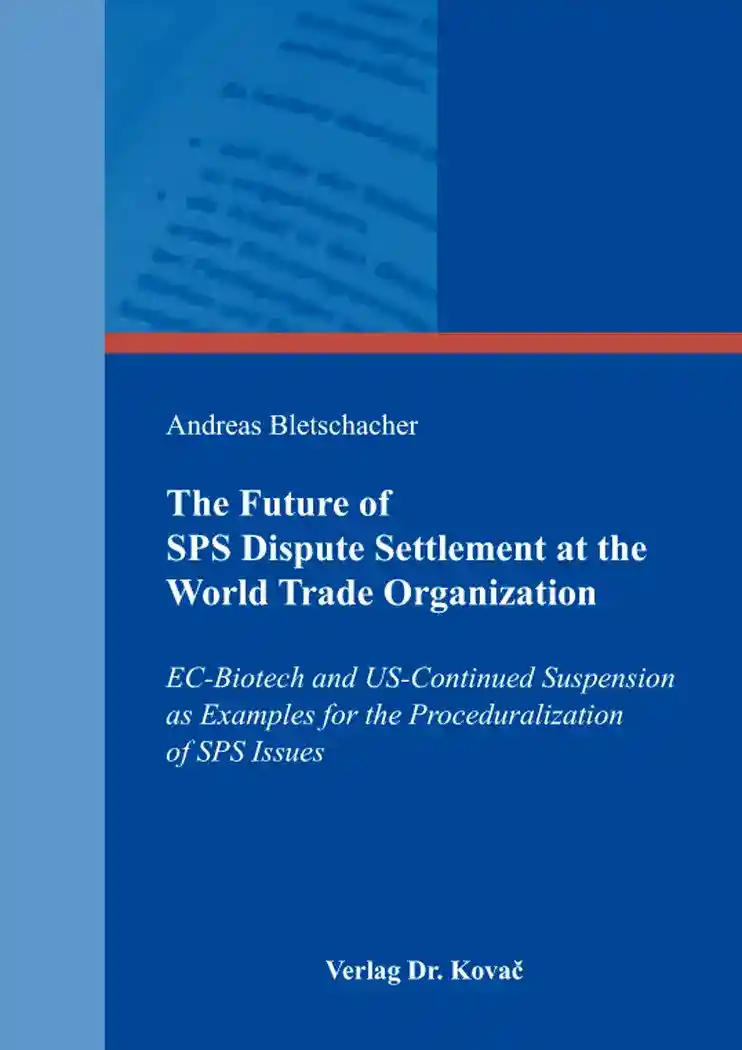Andreas BletschacherThe Future of SPS Dispute Settlement at the World Trade Organization
EC-Biotech and US-Continued Suspension as Examples for the Proceduralization of SPS Issues
– in englischer Sprache –
Studien zum Völker- und Europarecht, Band 139
Hamburg 2016, 266 Seiten
ISBN 978-3-8300-8991-9 (Print)
ISBN 978-3-339-08991-5 (eBook)
Zum Inhalt
First, the book aims to develop a theory of what the status of the WTO is and how it has developed so far.
Starting with a short description of the old GATT system, the first chapter introduces the reader to the multilateral trading system. The chapter provides an overview of the Dispute Settlement Mechanism and explain the new Dispute Settlement Understanding, established in the Uruguay Round.
Chapter II examines the health-related provisions of the GATT and shows why there was the necessity to develop more specific agreements in the course of the Uruguay Round. Conflicts existed in the area of food safety, animal and plant health already before the establishment of the WTO. These concerns were addressed in Art. XX (b) GATT 1947. However, since this Article was kept too general, WTO members created the SPS Agreement. Both agreements are relevant to measures for the protection of human, animal and plant health; therefore, it is necessary to examine the relationship between the SPS Agreement and GATT 1994.
Chapter III compares the two approaches. This chapter also introduces the reader to essential elements and regulations of the SPS Agreement, highlighted with decisions from older cases of SPS history. The basic principles of the SPS Agreement reflect the underlying goal of addressing the crucial need to open the market for food and agricultural products. The importance of this agreement is already high but will even increase in the future. With further cuts in tariffs, member countries will increasingly seek non-tariff measures to protect their own domestic markets. It is more challenging for member countries to eliminate regulatory barriers to trade than to reduce tariffs. Many regulations are legitimate and consider purposes not related to trade, whereas others may be designed for discriminatory purposes, to protect the domestic industry from the effects of globalization or to achieve other competitive advantages in contravention of specific trade agreements. It is challenging to distinguish between regulations that are in compliance with multilateral rules and those that protect domestic markets.
In chapter IV and V, a profound analysis of the new panel on the Hormones case according to Art. 21.5 DSU and of the GMO dispute are made. Just a few cases in the area of SPS have progressed to final decisions by the dispute settlement system. The Biotech and the Hormones cases have had a particularly remarkable impact on trade volumes. The GMO case presents an illustrative example of the increased regulatory divide between individual WTO members. The Panel report has not been appealed by the disputing parties, which could lead to the assumption that both parties were satisfied with the findings of the WTO panel. The author analyses if the outcomes of this case can really be judged as positive for both consumers in Europe as well as for companies producing biotech products. It will also be analysed if the final report of the Panel has led to a further clarification under which circumstances the regulations of the SPS Agreement do apply and if terms of the Agreement were explained that were not explained before.
In the final chapter, chapter VI, the three levels of health jurisdiction under SPS I (GATT), SPS II (EC-Hormones) and SPS III (United States § Continued Suspension of Obligations in the EC-Hormones Dispute, GMO case) are compared. It will provide an outlook of the future of SPS and suggest a more adequate handling of such disputes. The focus will be on chapter IV, V and VI. Chapters I-III serve as a basis and an explanation of the authors approach. It is a necessary condition to understand the history of SPS issues before entering into a discussion of recent developments and before making any proposals for the future. Having analysed developments in SPS, the final chapter concludes with the argument whether the SPS Agreement can be considered more as an opportunity or a threat to Public Health. The Agreement is a useful incentive to develop standards for better consumer protection. Products become safer when they have to fulfil specific standards and countries that comply with standards can export their products more easily to other countries. On the other hand, the results of SPS dispute settlement have been criticized by many NGOs and in addition, developing countries have continuous problems implementing the required standards. The role of international-standard setting bodies are discussed, and in particular if the influence on disputes will be further increased. In the disputes so far, the opinions of scientific experts of Codex, OIE and IPPC have been considered and the standards of the three-sister organizations have served as useful references to judge the legitimacy of SPS standards. This also raises the question if the development from negative to positive integration can be seen as an adequate solution for the regulation of international trade. Are there any other options than those of negative and positive integration or is the development towards positive integration the final step of trade integration? Is the WTO the right place to handle science-related disputes? The discussion in the final chapter addresses these questions.
